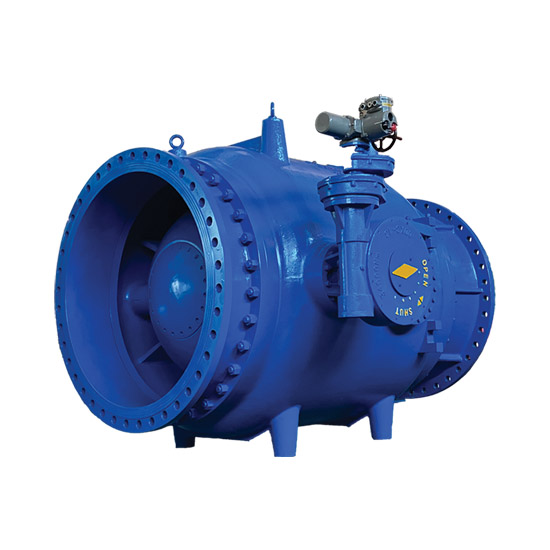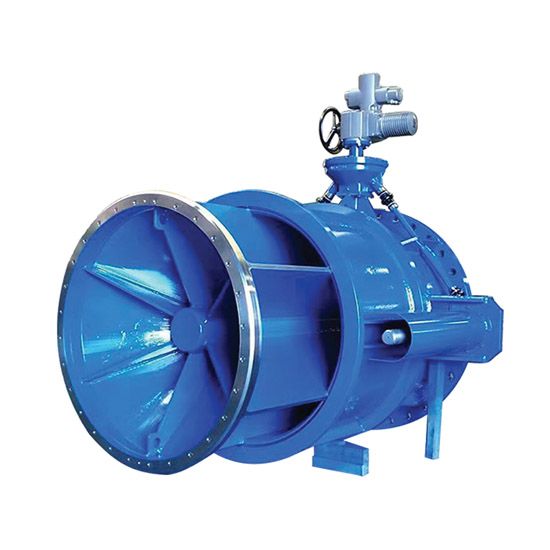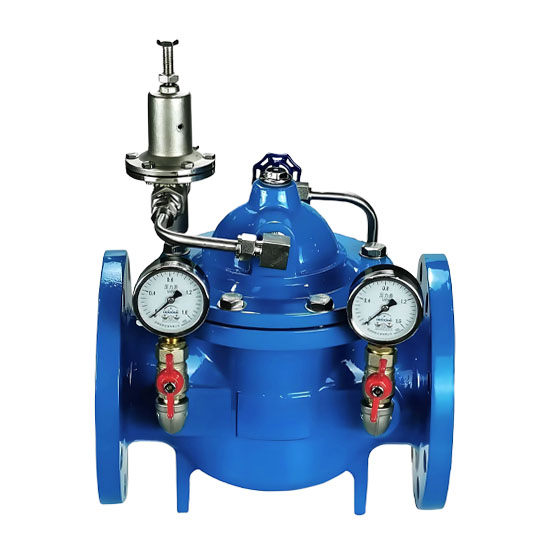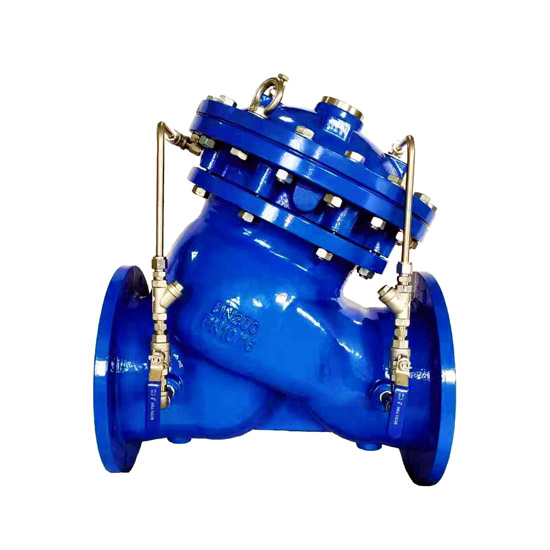I. Product Overview
1. Definition and Key Advantages
The piston-type flow and pressure regulating valve is a multifunctional control valve that adjusts the annular flow area between the piston and valve seat by axially moving the piston along the valve body, driven by a crank-slider mechanism. This enables precise flow control, stable pressure regulation, and energy dissipation. Its unique design addresses the shortcomings of traditional valves under high pressure, large differential pressure, and cavitation-prone conditions—such as poor control accuracy, seal failure, and complex maintenance. Key advantages include:
Linear Regulation and Stable Control: The piston opening is linearly correlated with flow rate and pressure (deviation ≤ ±5%), allowing precise maintenance of constant flow or downstream pressure. Especially suitable for pipeline zoning metering, pump start/stop protection, and turbine bypass pressure reduction.
Outstanding Anti-Cavitation and Energy Dissipation with Noise Reduction: Utilizes squirrel-cage multi-hole jet dissipation (for high differential pressure conditions) or blade-ring spiral guide dissipation (for clean media), concentrating cavitation bubbles in the center of the pipeline to prevent impact damage to the valve body and pipe walls. Vibration noise is significantly reduced (≤90 dB @ 1 m).
Low Operating Torque and Long Service Life: The piston features a pressure-balanced open-end design that offsets the “blind plate force” caused by medium pressure differential. Opening torque is only 1/3 to 1/5 of traditional valves. Dual eccentric guide rails and self-lubricating bronze bearings ensure long-term stable operation, suitable for large diameters (DN200–DN2000) and high-pressure systems (PN10–PN100).
Convenient Online Maintenance: Top-mounted structure allows replacement of piston seals, squirrel cage/blade ring components by simply opening the top valve cover—no need to remove piping or drain the medium.
Bidirectional Sealing and Zero Leakage: Metal hard seals (Stellite alloy or tungsten carbide) or rubber soft seals (EPDM/NBR) combinations ensure zero leakage in fully closed state. Soft seals meet ANSI Class VI, hard seals ≤0.1×DN mm³/s, suitable for bidirectional flow systems.
Typical Applications:
· Water Supply / Transmission Projects: Long-distance water transfer pressure reduction, municipal pipeline zoning pressure stabilization, flow dispatching in water treatment plants.
· Water Resources & Hydropower: Dam flood discharge control, hydropower station bypass discharge, turbine protection valves.
· Industrial Systems: Gas/liquid flow regulation in wastewater treatment plants, metallurgical slurry control, petrochemical two-phase flow pipelines.
· Building Water Supply & Drainage: Pressure reduction in high-rise buildings, flow balancing in fire protection systems.
II. Structural Design and Technical Principles
1. Crank-Slider Drive and Piston Regulation Mechanism
· Motion Mechanism: The valve shaft is rotated by electric, pneumatic, or manual actuators. Through a crank-linkage mechanism, rotary motion is converted into linear reciprocating motion of the piston along the central axis of the valve body. The piston movement alters the annular flow area between the piston and valve seat (fully open = straight-through flow; fully closed = complete shutoff), enabling continuous flow or pressure regulation.
· Low Torque Optimization: The piston adopts an open-end balanced structure, where front and rear pressure differentials cancel each other, greatly reducing thrust on the piston. Guide rails are made of welded or inlaid bronze alloy, offering extremely low friction and high wear resistance, further reducing operating torque (manual force for small diameters ≤360 N).
2. Flow Path and Energy Dissipation System
· Axially Symmetrical Annular Flow Path: The valve body features a dual-layer cylindrical design, maintaining a consistent annular cross-section for smooth fluid flow. Head loss coefficient ≤0.1 (fully open), approaching straight-through pipe flow, significantly improving energy efficiency.
· Anti-Cavitation and Energy Dissipation Structures:
o Squirrel-Cage Type (High Differential Pressure): The front end of the piston extends into a cylindrical cage with symmetrically distributed holes/slots. As the medium flows through, it is split into multiple high-speed jets that collide at the flow center, converting kinetic energy into pressure energy and canceling out forces. Cavitation bubbles collapse in the center, protecting the valve body and pipeline from cavitation damage.
o Blade-Ring Type (Clean Media / Medium-Low Differential Pressure): Guide blades are evenly distributed around the valve seat area, inducing spiral flow. Centrifugal force confines bubbles to the pipe center, and unstable bubbles burst away from the pipe wall, minimizing vibration and noise.
o Composite Designs Available: Flexible configurations to suit various operating conditions.
3. Seal System Design
Dual Seal Protection:
· Primary Seal (Piston to Outer Valve Body): Metal-to-metal (hard seal) or metal-to-rubber (soft + hard combination). Retaining ring anti-blowout structure ensures high-pressure sealing.
· Secondary Seal (Piston to Inner Guide Chamber): “I”-shaped seal ring design increases sealing force when closed and prevents seal ring deformation during operation.
Materials and Grades:
· Soft Seal: Reinforced EPDM/NBR rubber, temperature range -29℃ to 150℃, service life ≥20 years.
· Hard Seal: Floating Stellite alloy valve seat and spherical sealing surface (optimized hardness differential to prevent abrasion), suitable for high temperature (≤425℃) and abrasive conditions.
· Fire Safety Design: In case of non-metallic seal failure, built-in metal lip automatically contacts the piston, meeting API 6FA / ISO 10497 fire resistance standards.
4. Enhanced Guidance and Support System
· Bronze Guide Rail System: The piston is guided by ≥4 precision bronze alloy rails, ensuring smooth, centered movement and mitigating vibration risks under high flow rates.
· Dry Shaft Anti-Corrosion Structure: Both ends of the valve shaft feature dual-point sealing (seal rings between bearings and valve body), with bushings and bearings made of self-lubricating materials (e.g., PTFE composites), maintenance-free and corrosion-resistant.
· Integrated Valve Body Casting: Made from ductile iron QT450-10 or cast steel WCB, offering high strength and rigidity, minimizing stress deformation risks.
5. Anti-Clogging and Online Maintenance Structure
· Bottom Drainage and Flushing: The valve body includes a drain valve or backflush port to periodically remove fiber, particles, or scale buildup on the squirrel cage / blade ring surfaces.
· Modular Internal Components: Squirrel cage, piston assembly, and valve seat can be quickly disassembled and replaced via the top inspection port, ensuring efficient and convenient maintenance.
Hot Tags: Hydraulic Control Valve /





